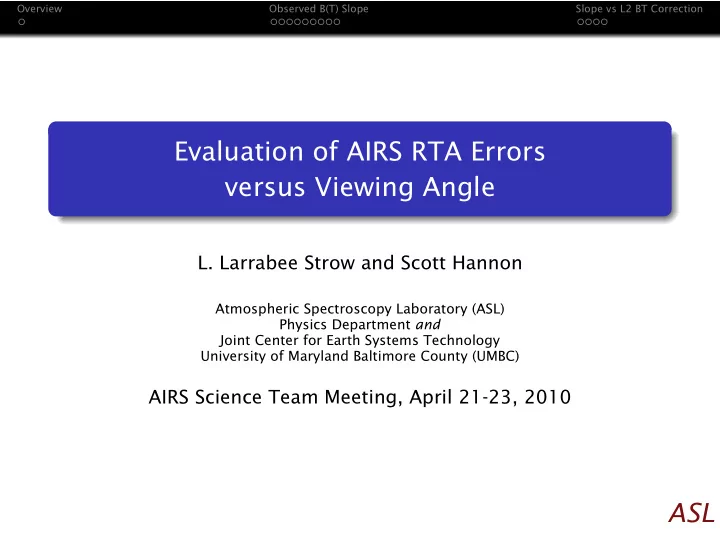

Overview Observed B(T) Slope Slope vs L2 BT Correction Evaluation of AIRS RTA Errors versus Viewing Angle L. Larrabee Strow and Scott Hannon Atmospheric Spectroscopy Laboratory (ASL) Physics Department and Joint Center for Earth Systems Technology University of Maryland Baltimore County (UMBC) AIRS Science Team Meeting, April 21-23, 2010 ASL
Overview Observed B(T) Slope Slope vs L2 BT Correction Overview Absolute, and relative, RTA errors still remain Possibly very important for CO 2 retrievals Introduce subtle biases into L2 products Present approach to mitigate RTA errors: L2 algorithm adds a fixed B(T) to the observed radiances New laboratory spectroscopy will probably not help at this level In-situ measurements probably not helpful either (maybe for H 2 O?) Model error should be independent of viewing angle Use bias errors versus ECMWF as a function of secant angle to correct RTA. Done by assimiation systems. ASL
Overview Observed B(T) Slope Slope vs L2 BT Correction Biases vs ECMWF Vary with Secant of Viewing Angle Spectroscopy errors will vary with viewing angle/secant since you are changing pathlength Assume ECMWF errors do not depend on secant angle Fit bias = offset + slope × secant Still need atmospheric constituent amount/profile to get spectroscopy, but second order error. ASL
Overview Observed B(T) Slope Slope vs L2 BT Correction Fit Results: Slope of d(bias)/d(sec) Secant varies from 1 to 1.37 IASI and AIRS biases produce almost same slope, implies spectroscopy and/or RTA paramterization errors. ASL
Overview Observed B(T) Slope Slope vs L2 BT Correction IASI and AIRS Disagree Near O 3 Region The fit R 2 statistic is low where they disagree, implying a linear slope cannot explain variation with secant. This is also a region of almost zero slope. ASL
Overview Observed B(T) Slope Slope vs L2 BT Correction AIRS Slope and Offset Offset is due to model (and maybe AIRS a little). Generally larger than slope. ASL
Overview Observed B(T) Slope Slope vs L2 BT Correction AIRS Slope Window regions might contain error in not using scene angle dependence of sea surface emissivity. Models available, not yet implemented. ASL
Overview Observed B(T) Slope Slope vs L2 BT Correction Secant Offset Highlights A/B Detector Calibration Secant offset, using nominal 300K BT data, shows A/B detector calibration differences. Slope does highlight HNO3 spectroscopy errors at 879 cm − 1 . ASL
Overview Observed B(T) Slope Slope vs L2 BT Correction Secant Offset Shows SW Module Offsets Slope error may be angle dependence of sea surface emissivity. Note strong water line slopes near zero. ASL
Overview Observed B(T) Slope Slope vs L2 BT Correction Secant Slope Agrees with Absolute Bias at 791.7 cm − 1 Extensive validation of 791.7 cm − 1 channel, using MLO CO 2 suggests +6 ppm adjustment to RTA. Agrees with bias slope using global data. ASL
Overview Observed B(T) Slope Slope vs L2 BT Correction Secan Slope in Water Band Suggests that RTA water spectroscopy is reasonably good, improvements possible? Note new HITRAN water already implemented, to some degree, in RTA using our empirical tuning soon after launch. ASL
Overview Observed B(T) Slope Slope vs L2 BT Correction Compare Slope Error to L2 BT Correction The B(T) slope with secant angle is top panel. Bottom is V5 Level 2 offset “correction” to radiances. (Independent of profile?) ASL
Overview Observed B(T) Slope Slope vs L2 BT Correction Compare Slope Error to L2 BT Correction: Zoom Top: Secant angle slope, Bottom: L2 B(T) offset correction ASL
Overview Observed B(T) Slope Slope vs L2 BT Correction Compare Slope Error to L2 BT Correction: Zoom Top: Secant angle slope, Bottom: L2 B(T) offset correction ASL
Overview Observed B(T) Slope Slope vs L2 BT Correction Conclusions Following the assimilation community, we should consider corrections to RTA using secant angle bias errors I would implement these corrections as adjustments to the gas optical depths, or equivalently to the absorber strength This approach is more physical than applying a B(T) offset to all spectra, regardless of the profile I do not know how the L2 correction is derived. Which correction is right? Consider this approach for V6? ASL
Recommend
More recommend